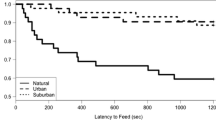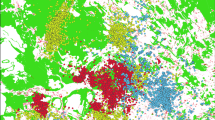Abstract
We combined the concept of mechanisms of co-existence with the approach of giving-up densities to study inter-taxon competition between seed-eating birds and mammals. We measured feeding behaviour in food patches to define and study the guild of seed-eating vertebrates occupying sandy habitats at Bir Asluj, Negev Desert, Israel. Despite a large number of putatively granivorous rodents and birds at the site, two gerbil species (Allenby's gerbil, Gerbillus allenbyi, and the greater Egyptian gerbil, G. pyramidum) dominated nocturnal foraging, and a single bird species (crested lark, Galerida cristata) contributed all of the daytime foraging. We used giving-up densities to quantify foraging behaviour and foraging efficiencies. A low giving-up density demonstrates the ability of a forager to profitably harvest food at low abundances and to profitably utilize the foraging opportunities left behind by the less efficient forager. Gerbils had lower giving-up densities in the bush than open microhabitat, and lower giving-up densities in the semi-stabilized than stabilized sand habitats. Crested larks showed the opposite: lower giving-up densities in the open than bush, and on the stabilized than semi-stabilized sand habitats. Despite these patterns, gerbils had substantially lower giving-up densities than crested larks in both microhabitats, all sand habitats, and during each month. Several mechanisms may permit the crested lark to co-exist with the gerbils. Larks may be cream skimmers on the high spatial and temporal variability in seed abundances. Larks may rely on insects, fruit or smaller seeds. Or, larks may rely on adjacent rocky habitats.
Similar content being viewed by others
References
Abramsky, Z. and Pinshow, B. (1989) Changes in foraging effort in two gerbil species with habitat type and intra-and interspecific activity. Oikos 56, 43–53.
Abramsky, Z., Brand, S. and Rosenzweig, M.L. (1985) Geographical ecology of gerbilline rodents in the sand dune habitats of Israel. J. Biogeogr. 12, 363–372.
Abramsky, Z., Rosenzweig, M.L., Pinshow, B., Brown, J.S., Kotler, B.P. and Mitchell, W.A. (1990) Habitat selection: An experimental field test with two gerbil species. Ecology 71, 2358–2369.
Abramsky, Z., Rosenzweig, M.L. and Pinshow, B. (1991) The shape of a gerbil isocline measured using principles of optimal habitat selection. Ecology 72, 329–340.
Benkman, C.W. (1991) Predation, seed size partitioning, and the evolution of body size in seed-eating finches. Evol. Ecol. 5, 118–127.
Bouskila, A. (1995) Interaction between predation risk and competition: A field study of kangaroo rats and snakes. Ecology 76, 165–178.
Bowers, M.A., Jefferson, J.L. and Kuebler, M.G. (1993) Variation in giving-up densities of foraging chipmunks (Tamias striatus) and squirrels (Sciurus carolinensis). Oikos 66, 229–236.
Brown, J.H. and Davidson, D.W. (1977) Competition between seed-eating rodents and ants in desert ecosystems. Science 196, 880–882.
Brown, J.H., Reichman, O.J. and Davidson, D.W. (1979) Granivory in desert ecosystems. Ann. Rev. Ecol. Syst. 10, 201–277.
Brown, J.H., Kodric-Brown, A., Witham, T.G. and Bond, H.W. (1981) Competition between hummingbirds and insects for the nectar of two species of shrubs. Southwest. Nat. 26, 133–145.
Brown, J.H., Davidson, D.W., Munger, J.C. and Inouye, R.C. (1986) Experimental community ecology: The desert granivore system. In Community Ecology (J.L. Diamond and T.J. Case, eds), pp. 41–61. Harper and Row, New York.
Brown, J.S. (1986) Coexistence on a resource whose abundance varies: A test with desert rodents. PhD thesis, University of Arizona, Tucson, AZ.
Brown, J.S. (1988) Patch use as an indicator of habitat preference, predation risk, and competition. Behav. Ecol. Sociobiol. 22, 37–47.
Brown, J.S. (1989) Desert rodent community structure: A test of four mechanisms of coexistence. Ecol. Monogr. 20, 1–20.
Brown, J.S. (1992) Patch use under predation risk: I. Models and predictions. Ann. Zool. Fenn. 29, 301–309.
Brown, J.S. and Alkon, P.U. (1990) Testing values of crested porcupine habitats by experimental food patches. Oecologia (Berl.) 83, 512–518.
Brown, J.S. and Morgan, R.A. (1995) Effects of foraging behavior and spatial scale on diet selectivity: A test with fox squirrels. Oikos 74, 122–136.
Brown, J.S. and Rosenzweig, M.L. (1986) Habitat selection in slowly regenerating environments. J. Theor. Biol. 123, 151–171.
Brown, J.S., Kotler, B.P., Smith, R.J. and Wirtz, W.O., II (1988) The effects of owl predation on the foraging behavior of heteromyid rodents. Oecologia (Berl.) 76, 408–415.
Brown, J.S., Arel, Y., Abramsky, Z. and Kotler, B.P. (1992a) Patch use by gerbils (Gerbillus allenbyi) in sandy and rocky habitats. J. Mammal. 73, 821–829.
Brown, J.S., Morgan, R.A. and Dow, B.D. (1992b) Patch use under predation risk: II. A test with fox squirrels, Sciurus niger. Ann. Zool. Fenn. 29, 311–318.
Brown, J.S., Kotler, B.P. and Mitchell, W.A. (1994a) Forging theory, patch use, and the structure of a Negev Desert granivore community. Ecology 75, 2286–2300.
Brown, J.S., Kotler, B.P. and Valone, T.J. (1994b) Foraging under predation: A comparison of energetic and predation costs in a Negev and Sonoran Desert rodent community. Austr. J. Zool. 42, 435–448.
Brownlee, K.A. (1965) Statistical Theory and Methodology in Science and Engineering, 2nd edn. John Wiley, New York.
Caraco, T. (1979) Time budgeting and group size: A theory. Ecology 60, 611–617.
Charnov, E.L. (1976) Optimal foraging and the marginal value theorem. Theor. Pop. Biol. 9, 129–136.
Cody, M.L. (1974) Competition and the Structure of Bird Communities. Princeton University Press, Princeton, NJ.
Cody, M.L. (ed.) (1985) Habitat Selection in Birds. Academic Press, New York.
Colwell, R.K. and Fuentes, E.R. (1975) Experimental studies of the niche. Ann. Rev. Ecol. Syst. 6, 281–310.
Craig, W. (1982) Enemy at the Gates: The Battle for Stalingrad. Bantam Books, New York.
Davidson, D.W., Inouye, R.S. and Brown, J.H. (1984) Granivory in a desert ecosystem: Evidence for indirect facilitation of ants by rodents. Ecology 65, 1780–1786.
Dayton, P.K. (1971) Competition, disturbance, and community organization: The provision and subsequent utilization of space in a rocky intertidal community. Ecol. Monogr. 41, 351–389.
Dunning, J.B. (1986) Shrub-steppe bird assemblages revisited: Implications for community theory. Am. Nat. 128, 82–98.
Fryxell, J.M. and Lundberg, P. (1994) Diet choice and predator-prey dynamics. Evol. Ecol. 8, 407–421.
Howe, H.F. (1980) Monkey dispersal and waste of a neotropical fruit. Ecology 61, 944–959.
Howe, H.F. (1990) Seed dispersal by birds and mammals: Implications for seedling demography. In Reproductive Ecology of Tropical Plants (K.S. Bawa and M. Hadley, eds), pp. 191–218. Man and Biosphere Series Vol. 7. UNESCO, Paris and Parthenon Publishing, Carnforth.
Hughes, J.J. and Ward, D. (1993) Predation risk and distance to cover affect foraging behaviour in Namib Desert gerbils. Anim. Behav. 46, 1243–1245.
Hughes, J.J., Ward, D. and Perrin, M.R. (1994) Predation risk and competition affect habitat selection and activity of Namib Desert gerbils. Ecology 75, 1397–1405.
Hughes, J.J., Ward, D. and Perrin, M.R. (1995) Effects of substrate on foraging decisions by a Namib Desert gerbil. J. Mammal. 76, 638–645.
Inouye, R.S. (1981) Interactions among unrelated species: Granivorous rodents, a parasitic fungus, and a shared prey species. Oecologia (Berl.) 49, 425–427.
Jedlicka, D. (1993) A foraging approach to habitat selection in time and space in three sciurid rodents. PhD dissertation, University of Illinois, Chicago, IL.
Kotler, B.P. and Brown, J.S. (1988) Environmental heterogeneity and the coexistence of desert rodents. Ann. Rev. Ecol. Syst. 19, 281–307.
Kotler, B.P. and Brown, J.S. (1990) Harvest rates of two species of gerbilline rodents. J. Mammal. 71, 591–596.
Kotler, B.P., Brown, J.S., Smith, R.J. and Wirtz, W.O., II (1988) The effects of morphology and body size on rates of owl predation on desert rodents. Oikos 53, 145–152.
Kotler, B.P., Brown, J.S. and Hasson, O. (1991) Owl predation on gerbils: The role of body size, illumination, and habitat structure on rates of predation. Ecology 72, 2249–2260.
Kotler, B.P., Brown, J.S. and Mitchell, W.A. (1993a) Environmental factors affecting patch use in two species of gerbilline rodents. J. Mammal. 74, 614–620.
Kotler, B.P., Brown, J.S. and Subach, A. (1993b) Mechanisms of species coexistence of optimal foragers: Temporal partitioning by two species of sand dune gerbils. Oikos 67, 548–556.
Kreuger, K. (1986) Feeding relationships among bison, pronghorn, and prairie dogs: An experimental analysis. Ecology 67, 760–770.
Lima, S.L. (1992) Strong preference for apparently dangerous habitats? A consequence of differential escape from predators. Oikos 64, 597–600.
Lima, S.L. (1993) Ecological and evolutionary perspectives on escape from predatory attack: A survey of North American birds. Wil. Bull. 105, 1–47.
Lubchenco, J. and Menge, B.A. (1978) Community development and persistence in a low rocky intertidal zone. Ecol. Monogr. 59, 67–94.
MacArthur, R.H. (1958) Population ecology of some warblers of northeastern coniferous forests. Ecology 39, 599–619.
MacArthur, R. and Pianka, E. (1966) On optimal use of a patchy environment. Am. Nat. 100, 603–609.
McNaughton, S.J. (1993) Grasses and grazers, science and management. Ecol. Appl. 3, 17–20.
Mitchell, W.A., Abramsky, Z., Kotler, B.P., Pinshow, B.P. and Brown, J.S. (1990) The effect of inter-and intra-specific competition on foraging effort: Theoretical development and a test with granivorous desert rodents in Israel. Ecology 71, 844–854.
Morgan, R.A. (1994) Using giving-up densities to investigate search images, functional responses and habitat selection. PhD thesis, University of Illinois, Chicago, IL.
Morris, D.W., Abramsky, Z., Fox, B.J. and Willig, M.R. (eds) (1989) Patterns in the Structure of Mammalian Communities. Special Publication No. 28 of the Museum, Texas Technical University, Lubbock, TX.
Morse, D.H. (1981) Interactions among syrphid flies and bumblebees on flowers. Ecology 62, 81–88.
Paine, R.T. (1966) Food web complexity and species diversity. Am. Nat. 100, 65–75.
Price, M.V. and Jenkins, S.H. (1986) Rodents as seed consumers and dispersers. In Seed Dispersal (D. Murray, ed.), pp. 242–261. Academic Press Australia, North Ryde.
Root, R. (1967) The niche exploitation pattern of the blue-grey gnatcatcher. Ecol. Monogr. 37, 317–350.
Rosenzweig, M.L. (1966) Community structure in sympatric carnivores. J. Mammal. 47, 602–620.
Rosenzweig, M.L. (1981) A theory of habitat selection. Ecology 62, 327–335.
Shkedy, J. (1990) Niche breadth and geographical distribution of the Desert Lark (Ammomanes deserti) and the Crested Lark (Galerida cristata). PhD dissertation, Hebrew University, Jerusalem.
Shkedy, J. (1992) Niche breadth of two lark species in the desert and the size of their geographical range. Ornis Scand. 23, 89–95.
Shkedy, Y. and Safriel, U.N. (1991) Fat reserves of an opportunist and of a specialist species in the Negev Desert. Auk 108, 556–561.
Smith, R.J. (1991) Predation risk and the community organization of montane ground squirrels and a phylogenetic test of association between diurnal activity and gregarious behavior in mammals. PhD dissertation, University of Arizona, Tucson, AZ.
Smith, R.J. (1995) Harvest rates and escape speeds in two coexisting species of montane ground squirrels. J. Mammal. 76, 189–195.
Sohonen, J., Halonen, M. and Mappes, T. (1993) Predation risk and the organization of the Parus guild. Oikos 66, 94–100.
Stewart, F.M. and Levin, B.R. (1973) Partitioning of resources and the outcome of interspecific competition: A model and some general considerations. Am. Nat. 107, 171–198.
Terborgh, J. (1983) Five New World Primates: A Study in Comparative Ecology. Princeton University Press, Princeton, NJ.
Terborgh, J., Robinson, S.K., Parker T.A., III, Munn, C.A. and Pierpont, N. (1990) Structure and organization of an Amazonian forest bird community. Ecol. Monogr. 60, 213–238.
Thompson, D.B., Brown, J.H. and Spencer, W.D. (1991) Indirect facilitation of granivorous birds by desert rodents: Experimental evidence from foraging patterns. Ecology 72, 852–863.
Tilman, D. (1982) Resource Competition and Community Structure. Princeton University Press, Princeton, NJ.
Turkington, R. and Harper, J.L. (1979) The growth, distribution, and neighbor relationship of Trifolium repens in a permanent pasture: Fine-scale biotic differentiation. J. Ecol. 62, 245–254.
Valone, T.J. and Brown, J.S. (1989) Measuring patch assessment abilities of desert granivores. Ecology 70, 1800–1810.
Vance, R.R. (1985) The stable coexistence of two competitors for one resource. Am. Nat. 126, 72–86.
Werner, E.E. (1992) Individual behavior and higher-order species interactions. Am. Nat. 140, S5–S32.
Ziv, Y., Abramsky, Z., Kotler, B.P. and Subach, A. (1993) Interference competition and temporal partitioning in two gerbil species. Oikos 66, 237–246.
Author information
Authors and Affiliations
Rights and permissions
About this article
Cite this article
Brown, J.S., Kotler, B.P. & Mitchell, W.A. Competition between birds and mammals: A comparison of giving-up densities between crested larks and gerbils. Evolutionary Ecology 11, 757–771 (1997). https://doi.org/10.1023/A:1018442503955
Issue Date:
DOI: https://doi.org/10.1023/A:1018442503955




